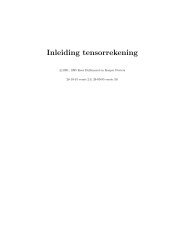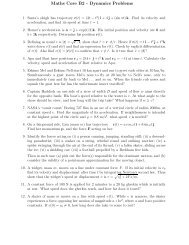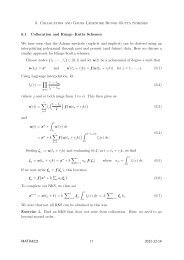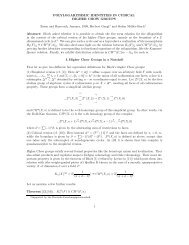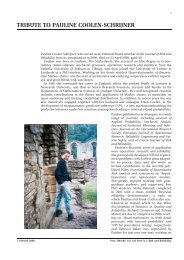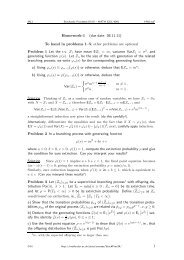solution
solution
solution
Create successful ePaper yourself
Turn your PDF publications into a flip-book with our unique Google optimized e-Paper software.
Complex Analysis II, Michaelmas 2012. Sheet 3: Harmonic Fns and Conformal Maps page 1<br />
Q.1 Check that the following functions are harmonic.<br />
(i) cos x cosh y , (ii) 3x 2 y − y 3 − 2(x 2 − y 2 ) ,<br />
(iii) log(x 2 + y 2 ) , (iv) y − y/(x 2 + y 2 ) .<br />
S.1 See <strong>solution</strong> on separate file.<br />
Q.2 Draw the region R and find real constants a and b such that:<br />
(i) u(x, y) = ax+b solves the Dirichlet problem on the region R = {x+iy : 0 ≤ x ≤ 6} with u(x, y) = 10<br />
on x = 0 and u(x, y) = 40 on x = 6.<br />
(ii) u(x, y) = ay+b solves the Dirichlet problem on the region R = {x+iy : 1 ≤ y ≤ 8} with u(x, y) = 2<br />
on y = 1 and u(x, y) = 100 on y = 8.<br />
(iii) u(x, y) = axy + b solves the Dirichlet problem on the region R = {x + iy : x ≥ 0, y ≥ 0, xy ≤ 4}<br />
with u(x, y) = 1 on the bounding half-lines and u(x, y) = 21 on the bounding hyperbola.<br />
(iv) u(x, y) = axy+b solves the Dirichlet problem on the region R = {x+iy : x ≥ 0, y ≥ 0, 1 ≤ xy ≤ 2}<br />
with u(x, y) = 0 on the left-lower bounding hyperbola and u(x, y) = 3 on the right-higher bounding<br />
hyperbola.<br />
(v) u(x, y) = a log(x 2 + y 2 ) + b solves the Dirichlet problem on the region R = {z : 1 ≤ |z| ≤ 5} with<br />
u(x, y) = 0 on |z| = 1 and u(x, y) = 100 on |z| = 5.<br />
(vi) u(x, y) = a log(x 2 + y 2 ) + b solves the Dirichlet problem on the region R = {z : 2 ≤ |z| ≤ e} with<br />
u(x, y) = 10 on |z| = 2 and u(x, y) = 70 on |z| = e.<br />
S.2 See <strong>solution</strong> on separate file<br />
Q.3 Check that the functions in Question 1 are the real parts of the following holomorphic functions, and hence<br />
find the corresponding harmonic conjugates of the harmonic functions in Question 1 (ie, write down the<br />
corresponding imaginary parts).<br />
(i) cos z (ii) −iz 3 − 2z 2 , (iii) 2 log z , (iv) −iz − (i/z) .<br />
S.3 See <strong>solution</strong> on separate file<br />
Q.4 Find the harmonic conjugates of the harmonic functions in Question 1 using the Cauchy-Riemann equations<br />
as demonstrated in lectures.<br />
S.4 See <strong>solution</strong> on separate file<br />
Q.5 Find the harmonic conjugate of e x cos y and the corresponding holomorphic function.<br />
S.5 Let u(x, y) = e x cos y; we look for v(x, y) satisfying the Cauchy-Riemann equations, i.e.<br />
So we need<br />
The first equation gives<br />
∂u ∂v<br />
=<br />
∂x ∂y ,<br />
∂v<br />
∂y = ex cos y,<br />
∂v<br />
= −∂u<br />
∂x ∂y<br />
∂v<br />
∂x = ex sin y<br />
v = e x sin y + g(x)<br />
∂v<br />
∂x = ex sin y + g ′ (x)<br />
and so the second equation gives e x sin y + g ′ (x) = e x sin y, hence g ′ (x) = 0 and therefore g(x) = C. So<br />
v(x, y) = e x sin y + C.<br />
And<br />
e x cos y + ie x sin y = e x (cos y + i sin y) = e x e iy = e x+iy = e z<br />
is the corresponding holomorphic function (or e z + iC).
Complex Analysis II, Michaelmas 2012. Sheet 3: Harmonic Fns and Conformal Maps page 2<br />
Q.6 Find the harmonic conjugate of x 3 − 3xy 2 + 4x and the corresponding holomorphic function.<br />
S.6 Let u(x, y) = x 3 − 3xy 2 + 4x; we look for v(x, y) satisfying the Cauchy-Riemann equations, i.e.<br />
So we need<br />
∂u ∂v<br />
=<br />
∂x ∂y ,<br />
∂v<br />
∂y = 3x2 − 3y 2 + 4,<br />
∂v<br />
= −∂u<br />
∂x ∂y<br />
∂v<br />
= 6xy<br />
∂x<br />
The second equation gives v(x, y) = 3x 2 y + g(y) and then the first gives<br />
so v(x, y) = 3x 2 y − y 3 + 4y + C.<br />
We check that<br />
3x 2 − 3y 2 + 4 = ∂v<br />
∂y = 3x2 + g ′ (y)<br />
g ′ (y) = −3y 2 + 4<br />
g(y) = −y 3 + 4y + C<br />
x 3 − 3xy 2 + i 3x 2 y − y 3 = x 3 + 3ix 2 y − 3xy 2 − iy 3 = x 3 + 3x 2 iy + 3x(iy) 2 + (iy) 3 = (x + iy) 3 = z 3 .<br />
Thus 3x 2 y − y 3 + 4y is the harmonic conjugate of x 3 − 3xy 2 + 4x, and z 3 + 4z is the corresponding<br />
holomorphic function. (Or 3x 2 y − y 3 + 4y + C and z 3 + 4z + iC.)<br />
Q.7 Find the harmonic conjugate of cosh x cos y.<br />
S.7 Let u(x, y) = cosh x cos y; we look for v(x, y) satisfying the Cauchy-Riemann equations, i.e.<br />
So we need<br />
∂v<br />
∂y<br />
∂u ∂v<br />
=<br />
∂x ∂y ,<br />
∂u<br />
= = sinh x cos y,<br />
∂x<br />
∂v<br />
= −∂u<br />
∂x ∂y<br />
∂v<br />
= −∂u = cosh x sin y<br />
∂x ∂y<br />
The first equation gives v(x, y) = sinh x sin y + g(x) and then the second gives<br />
cosh x sin y = ∂v<br />
∂x = cosh x sin y + g′ (x)<br />
g ′ (x) = 0<br />
g(x) = C<br />
So v(x, y) = sinh x sin y + C. You may care to check that cosh z (or cosh z + iC) is the corresponding<br />
holomorphic function.<br />
Q.8 (a) Find a harmonic function defined on the region of the (u, v)-plane between u = 2 and u = 3 taking<br />
the value 3 on the left-hand boundary and 5 on the right-hand.<br />
(b) Using part (a), find a harmonic function defined on the region of the (x, y)-plane between y = x−2 √ 2<br />
and y = x − 3 √ 2 taking the value 3 on the upper boundary and 5 on the lower.<br />
S.8 (a) Let ϕ(u, v) be such a function. On the boundary of the region, the value of ϕ is independent of v, so<br />
we may expect that, if w = u + iv then<br />
ϕ(u, v) = Au + B = Re(Aw + B),
Complex Analysis II, Michaelmas 2012. Sheet 3: Harmonic Fns and Conformal Maps page 3<br />
where A, B ∈ R. Putting in the boundary conditions we get<br />
giving A = 2, B = −1 and hence<br />
2A + B = 3<br />
3A + B = 5<br />
ϕ(u, v) = 2u − 1 = Re(2w − 1).<br />
(b) If you draw the two given lines in the (x, y)-plane (see left-hand picture below), you see that rotating<br />
by π/4 could be a good thing to try. So, let w = f(z) = u + iv = e iπ/4 (x + iy). Then<br />
so that<br />
(x + iy) = e −iπ/4 (u + iv) = 1<br />
√ 2 (1 − i)(u + iv),<br />
x = 1<br />
√ 2 (u + v) , y = 1<br />
√ 2 (−u + v) .<br />
So the first line in the (x, y)-plane is mapped to the line −u + v = u + v − 4, ie to the line u = 2,<br />
and the second line in the (x, y)-plane is similarly mapped to the line u = 3. A theorem discussed in<br />
the module now tells us that ˜ϕ(x, y) = ϕf(x, y) is harmonic on the (x, y)-plane, and the construction<br />
shows that ˜ϕ(x, y) has the correct boundary conditions. Explicitly,<br />
<br />
1<br />
˜ϕ(x, y) = ϕf(x, y) = ϕ √2 (1 + i)(x + iy) = √ 2(x − y) − 1.<br />
[You could check directly that this is harmonic on the (x, y)-plane and takes the correct values on the<br />
bounding lines.]<br />
z = x + iy<br />
.<br />
.<br />
.<br />
. .<br />
. .<br />
. . .<br />
. .<br />
. .<br />
.<br />
. . .<br />
. . .<br />
. . .<br />
. . .<br />
. . .<br />
. . .<br />
. . .<br />
. . .<br />
. . .<br />
. . .<br />
. . .<br />
. . .<br />
. . .<br />
. . .<br />
. . .<br />
. .<br />
. .<br />
. . .<br />
. . .<br />
. . .<br />
. . .<br />
. . .<br />
. . .<br />
. . .<br />
. . .<br />
. . .<br />
. . .<br />
. . .<br />
. . .<br />
. .<br />
. .<br />
.<br />
.<br />
.<br />
. . y = x − 2<br />
.<br />
.<br />
. .<br />
. .<br />
. . .<br />
. .<br />
. . .<br />
√ 2<br />
−→<br />
y = x − 3 √ 2 w = u + iv<br />
π<br />
i Figure 1: w = ze 4<br />
u = 2<br />
. . .<br />
. . .<br />
. . .<br />
. . .<br />
. . .<br />
. . .<br />
. . .<br />
. . .<br />
. . .<br />
. . .<br />
. . .<br />
. . .<br />
. . .<br />
. . .<br />
. . .<br />
. . .<br />
. . .<br />
. . .<br />
. . .<br />
. . .<br />
. . .<br />
. . .<br />
. . .<br />
. . .<br />
. . .<br />
. . .<br />
. . .<br />
. . .<br />
. . .<br />
. . .<br />
. . .<br />
. . .<br />
. . .<br />
. . .<br />
. . .<br />
. . .<br />
. . .<br />
. . .<br />
. . .<br />
. . .<br />
. . .<br />
. . .<br />
. . .<br />
. . .<br />
. . .<br />
. . .<br />
. . .<br />
. . .<br />
. . .<br />
. . .<br />
. . .<br />
. . .<br />
. . .<br />
u = 3<br />
Q.9 (a) Find a harmonic function defined on the region of the (u, v)-plane between u = −1 and u = −3 taking<br />
the value −5 on the left-hand boundary and 1 on the right-hand.<br />
(b) Using part (a), find a harmonic function defined on the region of the (x, y)-plane between y = √ 3x+2<br />
and y = √ 3x + 6 taking the value 1 on the lower boundary and −5 on the upper.<br />
S.9 (a) Let ϕ(u, v) be such a function. On the boundary of the region the value of ϕ is independent of v, so<br />
we may expect that, if w = u + iv, then<br />
ϕ(x, y) = Au + B = Re(Aw + B),
Complex Analysis II, Michaelmas 2012. Sheet 3: Harmonic Fns and Conformal Maps page 4<br />
where A, B ∈ R. Putting in the boundary conditions we get<br />
giving A = 3, B = 4 and hence<br />
−3A + B = −5<br />
−A + B = 1<br />
ϕ(u, v) = 3u + 4 = Re(3w + 4).<br />
(b) If you draw the two given lines in the (x, y)-plane (see left-hand picture below), you see that rotating<br />
by π/6 could be a good thing to try. So, let w = f(z) = u + iv = e iπ/6 (x + iy). Then<br />
so that<br />
(x + iy) = e −iπ/6 (u + iv) = 1<br />
2 (√ 3 − i)(u + iv),<br />
x = 1<br />
2 (√ 3u + v) , y = 1<br />
2 (−u + √ 3v) .<br />
So the first line in the (x, y)-plane is mapped to the line −u + √ 3v = √ 3( √ 3u + v) + 4, ie to the<br />
line u − 1, and the second line in the (x, y)-plane is similarly mapped to the line u = −3. A theorem<br />
discussed in the module now tells us that ˜ϕ(x, y) = ϕf(x, y) is harmonic on the (x, y)-plane, and the<br />
construction shows that ˜ϕ(x, y) has the correct boundary conditions. Explicitly,<br />
<br />
1<br />
˜ϕ(x, y) = ϕf(x, y) = ϕ<br />
2 (√ <br />
3 + i)(x + iy)<br />
= 3<br />
2 (√ 3x − y) + 4.<br />
[You could check directly that this is harmonic on the (x, y)-plane and takes the correct values on the<br />
bounding lines.]<br />
. . . . .<br />
. . . .<br />
. . . .<br />
. . . .<br />
. . . .<br />
. . . .<br />
. . .<br />
. . .<br />
. . .<br />
. . .<br />
. . .<br />
. . .<br />
. . . .<br />
. . . .<br />
. . .<br />
. . .<br />
. . .<br />
. . .<br />
. . .<br />
. . .<br />
. . . .<br />
. . . .<br />
. . .<br />
. . . π<br />
. . . .<br />
. . . 3<br />
. . .<br />
. . .<br />
. . . .<br />
. . . .<br />
. . .<br />
. . .<br />
. . .<br />
. . .<br />
. . .<br />
. . .<br />
. . .<br />
. . .<br />
. .<br />
. .<br />
.<br />
.<br />
y = √ 3x + 2<br />
y = √ . . . .<br />
.<br />
3x + 6 u = −3 . . . .<br />
. . . . u = −1<br />
−→<br />
. . . .<br />
. . . .<br />
. . . .<br />
. . . .<br />
. . . .<br />
. . . .<br />
. . . .<br />
. . . .<br />
. . . .<br />
. . . .<br />
. . . .<br />
. . . .<br />
. . . .<br />
. . . .<br />
. . . .<br />
. . . .<br />
. . . .<br />
. . . .<br />
. . . .<br />
. . . .<br />
. . . .<br />
. . . .<br />
. . . .<br />
. . . .<br />
. . . .<br />
. . . .<br />
. . . .<br />
. . . .<br />
. . . .<br />
. . . .<br />
. . . .<br />
. . . .<br />
. . . .<br />
. . . .<br />
. . . .<br />
. . . .<br />
z = x + iy . . . .<br />
. . . . w = u + iv<br />
π<br />
i Figure 2: w = ze 6<br />
. . . .<br />
. . . .<br />
. . . .<br />
. . . .<br />
. . . .<br />
. . . .<br />
. . . .<br />
. . . .<br />
. . . .<br />
. . . .<br />
. . . .<br />
. . . .<br />
Q.10 Let f(z) = 1 + i √ 3 z. Describe f as a rotation followed by a dilation. Hence draw the image under f of<br />
the unit circle |z| = 1 and of the line x = y.<br />
S.10 We have<br />
f(z) =<br />
<br />
1 + i √ <br />
<br />
√<br />
1 3<br />
3 z = 2 + i<br />
2 2<br />
<br />
<br />
z = 2 cos π<br />
3<br />
π<br />
<br />
π<br />
i<br />
+ i sin z = 2e 3 z<br />
3<br />
Thus f is rotation about the origin through an angle π<br />
3 followed by dilation by 2. The unit circle is ampped<br />
to the<br />
Q.11 Let f(z) = (1 − i) z. Describe f as a rotation followed by a dilation. Hence draw the image under f of the<br />
unit circle |z| = 1 and of the line x = y.
Complex Analysis II, Michaelmas 2012. Sheet 3: Harmonic Fns and Conformal Maps page 5<br />
S.11 We have<br />
f(z) = (1 − i) z = √ <br />
1<br />
2 √2 − i 1<br />
<br />
√ z =<br />
2<br />
√ <br />
2 cos<br />
− π<br />
4<br />
<br />
+ sin<br />
Thus f is rotation about the origin through an angle − π<br />
4 followed by dilation by √ 2.<br />
− π<br />
4<br />
<br />
z = √ π<br />
−i<br />
2e 4 z<br />
Q.12 Let f(z) = √ 2 (1 − i) z + 2 − 4i. Describe f as a rotation followed by a dilation followed by a translation.<br />
Hence draw the image under f of the unit circle |z| = 1 and of the line x = y.<br />
S.12 We have<br />
f(z) = √ 2 (1 − i) z + 2 − 4i<br />
iπ<br />
−<br />
= 2e 4 z + 2 − 4i .<br />
Thus f is rotation about the origin through an angle − π<br />
4 followed by dilation by 2, followed by translation<br />
through 2 − 4i.<br />
Q.13 Let f(z) = 2 1 − i √ 3 z +6+5i. Describe f as a rotation followed by a dilation followed by a translation.<br />
Hence draw the image under f of the unit circle |z| = 1 and of the line x = y.<br />
S.13 Here, f(z) = 4e i5π<br />
3 z + 6 + 5i. Thus f is rotation about the origin through an angle 5π<br />
3<br />
by 4, followed by translation through 6 + 5i.<br />
followed by dilation<br />
Q.14 Let f(z) = −1 − i √ 3 z+3−2i. Describe f as a rotation followed by a dilation followed by a translation.<br />
Hence draw the image under f of the unit circle |z| = 1 and of the line x = y.<br />
S.14 Here, f(z) = 2e i4π<br />
3 z + 3 − 2i. Thus f is rotation about the origin through an angle 4π<br />
3<br />
by 2, followed by translation through 3 − 2i.<br />
followed by dilation<br />
Q.15 By noting that az + b = a(z + (b/a)) show that if f(z) = az + b, with a = 0, then f may be decribed as<br />
a translation followed by a rotation followed by a dilation. Describe f(z) = √ 2 (1 − i) z + 2 − 4i in this<br />
way.<br />
S.15 We have<br />
where<br />
Thus<br />
iπ<br />
−<br />
2e 4 w = 2 − 4i<br />
w = e iπ<br />
4 (1 − 2i) =<br />
f(z) = √ 2 (1 − i) z + 2 − 4i<br />
iπ<br />
iπ<br />
− −<br />
= 2e 4 z + 2 − 4i = 2e 4 (z + w)<br />
<br />
1<br />
√2 + i<br />
<br />
√ (1 − 2i) =<br />
2<br />
1<br />
3 − i<br />
√ (1 + i) (1 − 2i) = √<br />
2 2<br />
<br />
iπ<br />
−<br />
f(z) = 2e 4 z +<br />
<br />
3 − i<br />
√<br />
2<br />
So f is translation through 3−i<br />
√ 2 , followed by rotation about the origin through an angle − π<br />
4<br />
dilation by 2.<br />
Q.16 In what subset of the complex plane is 2z 3 + 3z 2 conformal?<br />
followed by<br />
S.16 Let f(z) = 2z 3 + 3z 2 ; then f ′ (z) = 6z 2 + 6z = 6z(z + 1). Thus for z = 0, −1, f ′ (z) = 0 and so f is<br />
conformal in C \ {0, −1} but not at 0 or −1.
Complex Analysis II, Michaelmas 2012. Sheet 3: Harmonic Fns and Conformal Maps page 6<br />
Q.17 In what subset of the complex plane is 2z 3 − 6z 2 + 6z conformal?<br />
S.17 Let f(z) = 2z 3 − 6z 2 + 6z; then f ′ (z) = 6z 2 − 12z + 6 = 6(z − 1) 2 . Thus for z = 1, f ′ (z) = 0 and so f<br />
is conformal in C \ {1}, but not at z = 1 because f ′ (1) = 0.<br />
Q.18 In what subset of the complex plane is 2z 3 − 3 (1 + i) z 2 + 6iz conformal?<br />
S.18 Let f(z) = 2z 3 − 3 (1 + i) z 2 + 6iz; then<br />
f ′ (z) = 6z 2 − 6 (1 + i) z + 6i<br />
= 6 z 2 − (1 + i) z + i <br />
= 6 (z − 1) (z − i) .<br />
Thus for z = 1, i, we see that f ′ (z) = 0. Hence f is conformal in C \ {1, i}, but not for z ∈ {1, i} because<br />
f ′ (z) = 0 there.<br />
Q.19 In what subset of the complex plane is z 3 + 3<br />
2 (1 − 2i) z2 − 6iz + 4 conformal?<br />
S.19 Let f(z) = z 3 + 3<br />
2 (1 − 2i) z2 − 6iz + 4; then<br />
f ′ (z) = 3 z 2 + (1 − 2i)z − 2i <br />
= 3 (z − 2i) (z + 1)<br />
Thus for z = −1, 2i, we see that f ′ (z) = 0. Hence f is conformal in C \ {−1, 2i}, but not for z ∈ {−1, 2i}<br />
because f ′ (z) = 0 there.<br />
Q.20 In what subset of the complex plane is sinh z conformal?<br />
S.20 Let f(z) = sinh z, so that f ′ (z) = cosh z. Certainly f(z) is holomorphic on C and<br />
where n ∈ Z. Let<br />
f ′ (z) = 0<br />
⇐⇒ e z + e −z = 0<br />
S =<br />
Thus f(z) is conformal on C − S but not on S.<br />
⇐⇒ e 2z = −1<br />
⇐⇒ e 2z = e i(π+2nπ)<br />
<br />
π<br />
<br />
⇐⇒ z = i + nπ<br />
2<br />
<br />
π<br />
i<br />
2<br />
<br />
+ nπ : n ∈ Z<br />
Q.21 At which points in C are the following maps conformal?<br />
(a) x + iy ↦−→ x − 2yi (b) z ↦−→ z 2 + 1<br />
In both cases give an example of two curves through the origin such that the angle between them is not<br />
preserved by f(z).<br />
S.21 (a) f(z) = x − 2iy is not holomorphic anywhere, since x and −2y do not satisfy the Cauchy-Riemman<br />
equations anywhere. Therefore it is not conformal at any point of C. (You can also write f(z) = 1<br />
2 (−z +3¯z)<br />
to show that it is not holomorphic.)<br />
(b) f(z) = z 2 + 1 is holomorphic but f ′ (z) = 2z = 0 only when z = 0. So f is conformal in C − {0}<br />
Consider the line segments γ1(t) = te iθ1 , γ2(t) = te iθ2 , t ∈ [0, 1], θ1 = θ2 and their images.<br />
Q.22 Let f(z) = z 2 + 2z. Show that f is conformal at z = i and describe the effect on the tangent vectors of<br />
curves passing through the point.
Complex Analysis II, Michaelmas 2012. Sheet 3: Harmonic Fns and Conformal Maps page 7<br />
S.22 First note<br />
f ′ (z) = 2z + 2<br />
f ′ (i) = 2 + 2i = 0<br />
so that f(z) is conformal at z = i. Now arg f ′ (i) = π<br />
π<br />
, so the tangent vectors at z = i are rotated by<br />
4 4 .<br />
The dilation factor is <br />
f ′ (i) = √ 4 + 4 = 2 √ 2.<br />
Q.23 Let f(z) = 2z 3 + 3z 2 . Show that f is conformal at z = i and describe the effect on the tangent vectors of<br />
curves passing through the point.<br />
S.23 First note<br />
f ′ (z) = 6z 2 + 6z<br />
f ′ (i) = −6 + 6i = 0<br />
so that f(z) is conformal at z = i. Now arg f ′ (i) = 3π<br />
3π<br />
, so the tangent vectors at z = i are rotated by<br />
4 4 .<br />
The dilation factor is <br />
f ′ (i) = 62 + 62 = 6 √ 2.<br />
Q.24 Let f(z) = z 4 + 4z. Show that f is conformal at z = i and describe the effect on the tangent vectors of<br />
curves passing through the point.<br />
S.24 First note<br />
f ′ (z) = 4z 3 + 4<br />
f ′ (i) = 4 − 4i = 4(1 − i)<br />
so f(z) is conformal at z = i.<br />
Now arg f ′ (i) = − π<br />
<br />
or<br />
4<br />
7π<br />
<br />
, so that the tangent vectors at z = i are rotated by −<br />
4<br />
π<br />
4<br />
dilation factor is √<br />
f ′<br />
(i) = 4 2.<br />
= 0<br />
<br />
or 7π<br />
<br />
. The<br />
4<br />
Q.25 Is the following true or false? If f, g are conformal at a point z0 then f + g is conformal at z0. Give a proof<br />
or a counter-example.<br />
S.25 False. For let f(z) = z + z 2 , g(z) = −z and z0 = 0. Then f ′ (0) = 1, g ′ (0) = −1 so both f and g are<br />
conformal at z = 0. But f(z) + g(z) = z 2 , which is not conformal at z = 0 because its derivative is 0<br />
there.



